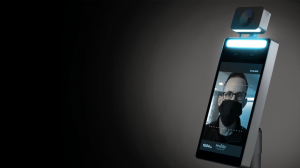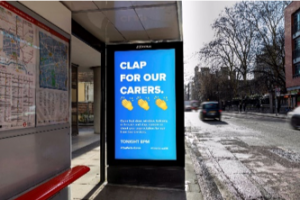Although many aspects of digital signage and Out-of-Home in general suffered since the start of the COVID-19 pandemic, we can’t deny how certain others stood out and blossomed. Of course, as new technologies develop with applications specific to the times ahead, they’re bound to succeed. But we must not ignore the already-existing aspects of digital signage which managed to pull through and in some cases even shine in this difficult time.
Besides technology, content is another element of digital signage which changed significantly. Not only have most ads by big brands shifted to a more somber tone with the #StaySafe hashtag, but also new content types have emerged, including restriction reminders, suggestions, and public safety announcements.
New technology focusing on COVID-19
It is expected many months will pass before the influence of COVID-19 begins to lessen. For this reason, digital signage companies are adapting and investing in new technology focusing on uses during the pandemic.
One excellent example of new tech is the Thermo-Scanner by Reality Interactive. This thermal scanner/screen is designed to provide access control to any establishment. It does this by measuring body temperature of the person in front of it.
It doesn’t require human interaction like most other temperature check points, lowering the risk of spreading COVID-19. Integrations of similar technologies with digital signage will likely become more common in the months ahead. It only makes sense, given that companies are looking for opportunities at this time to provide an immediate solution.
New uses for existing technology
There are plenty of sides to digital signage technology that weren’t quite as popular a year ago. Given the current situation, there is plenty of existing technology more frequently utilized and even finding new use cases.
Digital signage can keep track of crowd density. There are several ways to achieve this: through AI or through QR codes, for instance. Digital displays could track the number of people entering an establishment and displaying the number, alongside the limit of people allowed inside. You could also use QR codes to allow users to interact, register, or even start a virtual queue so they don’t have to wait in front of a store. Using digital displays to highlight the most/least busy times of the day is another piece of information very useful at this time.
QR codes and interacting with digital displays through smartphones were the “less cool” approaches prior to the pandemic. Touchscreens were the quickest and most direct path to interaction, but as the public way of thinking shifts due to contamination concerns of surfaces, formerly uncool methods suddenly become more interesting.
Battery powered sandwich boards for COVID-19 information
Speaking of existing technology starting to shine, these simple movable digital boards are gaining traction as they find a new home in front of stores, restaurants and businesses. Using trigger sensors, they display messages to people walking in and out of the store. They are also found at public locations to inform, remind, or simply keep track of crowds. Primarily made and marketed in China, they’re slowly spreading to the rest of the globe.
These boards seem to be excellent additions to any restaurant, cafe, or business of a different sort. But it remains uncertain if owners will be willing to invest in them. On one side, a simple print version could provide the same information this digital board does, but at a much lower cost and risk of theft. On the other hand, however, a digital board could display more information and potentially replace a staff member who would otherwise need to keep track of foot traffic.
A new variety of content and uses
The tech side of digital signage isn’t the only one to find new uses. The content side is blossoming as well, as new forms of content emerge. One excellent example is the Clap For Our Carers campaign. It inspired digital signs saluting the workers in the front lines of the fight against COVID-19.
Brands are using outdoor advertising wisely through content which encourages social distancing. For example, to show their support to this, McDonald’s in Brazil separated their golden arches in a recently released campaign.
Another content category emerging are PSAs (Public Safety Announcements). Many sites and brands have been kind enough to produce them and make them available for free. They focus on a variety of topics. These can include practical information such as maintaining a standard for hygiene, as well as any other relevant restriction or information. Others may remind people to stay active, be safe, and to stay positive.

Observing these growing aspects of digital signage is very reminiscent of trying to predict the upcoming trends a year in advance. The main difference is that public habits and behavior are more uncertain than ever, making it difficult to pinpoint what it is that makes people respond the most. Still, there is much opportunity for testing and trying new things. Judging by how successful the aspects above were in their influence, you would do well to do some content and/or tech testing of your own!









